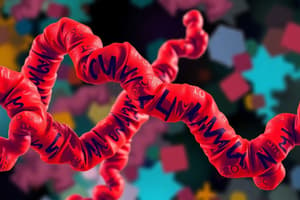Podcast
Questions and Answers
Which type of interaction stabilizes the tertiary structure of a protein?
Which type of interaction stabilizes the tertiary structure of a protein?
- Ionic bonds
- Hydrogen bonds
- Van der Waals forces
- All of the above (correct)
Which property of amino acids primarily determines their interactions in water?
Which property of amino acids primarily determines their interactions in water?
- Hydrogen bonding capacity
- Charge of the amino group
- Size of the side chain
- Polarity of the side chain (correct)
What occurs during the condensation reaction in polypeptide formation?
What occurs during the condensation reaction in polypeptide formation?
- Water is produced and a peptide bond is formed (correct)
- A peptide bond is broken and water is consumed
- Nucleic acids are formed from amino acids
- Amino acids are released from proteins
Which type of bond specifically links amino acids in a protein?
Which type of bond specifically links amino acids in a protein?
Which of the following statements about hydrophobic and hydrophilic properties is true?
Which of the following statements about hydrophobic and hydrophilic properties is true?
Which structure of a protein is primarily determined by the sequence of amino acids?
Which structure of a protein is primarily determined by the sequence of amino acids?
What is a defining characteristic of proteins with a quaternary structure?
What is a defining characteristic of proteins with a quaternary structure?
Which type of amino acid side chain would most likely be found in the interior of a folded protein?
Which type of amino acid side chain would most likely be found in the interior of a folded protein?
What is formed when amino acids join together through a condensation reaction?
What is formed when amino acids join together through a condensation reaction?
Which level of protein structure refers to the sequence of amino acids?
Which level of protein structure refers to the sequence of amino acids?
Which of the following correctly describes a peptide bond?
Which of the following correctly describes a peptide bond?
What is the by-product of the condensation reaction between two amino acids?
What is the by-product of the condensation reaction between two amino acids?
What does the secondary structure of a protein involve?
What does the secondary structure of a protein involve?
Which of these properties primarily influences the folding of amino acids in proteins?
Which of these properties primarily influences the folding of amino acids in proteins?
What is produced when two monomers join together in a condensation reaction?
What is produced when two monomers join together in a condensation reaction?
In what cellular location does the joining of amino acids to form polypeptides occur?
In what cellular location does the joining of amino acids to form polypeptides occur?
What is the primary bond that links nucleotides together in nucleic acids?
What is the primary bond that links nucleotides together in nucleic acids?
What type of reaction forms the phosphodiester bond between nucleotides?
What type of reaction forms the phosphodiester bond between nucleotides?
What structure is described as the sugar-phosphate backbone of nucleic acids?
What structure is described as the sugar-phosphate backbone of nucleic acids?
How do DNA strands bond together?
How do DNA strands bond together?
In what orientation do the two strands of DNA run relative to each other?
In what orientation do the two strands of DNA run relative to each other?
Which of the following accurately describes a phosphodiester bond?
Which of the following accurately describes a phosphodiester bond?
What type of bond primarily holds the structure of nucleotides together?
What type of bond primarily holds the structure of nucleotides together?
What is a by-product of condensation reactions that form the backbone of nucleic acids?
What is a by-product of condensation reactions that form the backbone of nucleic acids?
Flashcards are hidden until you start studying
Study Notes
Blood Test Results
- Individual A and Individual B both exhibit high hemoglobin levels.
- Individual B also shows a low red blood cell count, indicating a potential health issue.
Proteome
- Refers to all proteins present in a cell, tissue, or organism at a specific moment in time.
- It is distinct from the complete set of chromosomes or genes coding for proteins.
Protein Structure and Function
- Tertiary structure stabilised by disulphide bridges is an important feature of proteins.
- Variability in amino acid sequences results in different protein functions.
- Changes in the secondary structure can significantly impact protein function.
- Quaternary structures do not guarantee higher activity compared to non-quaternary proteins.
Functional Protein Structure
- Functional proteins require a tertiary structure to perform biological functions effectively.
Organic Molecule Formation
- The diagram represents the joining of organic monomers, specifically amino acids.
- Amino acids act as monomers that combine through a condensation reaction to form polypeptides (polymers).
- Peptide bonds link adjacent amino acids, producing water as a by-product.
Protein Structure Overview
- Four levels of protein structure:
- Primary: Sequence of amino acids.
- Secondary: Formation of alpha-helices and beta-pleated sheets.
- Tertiary: 3D functional shape of the protein.
- Quaternary: Bonding of multiple polypeptide chains.
Nucleotides and Nucleic Acids
- Phosphodiester bonds are strong covalent links formed between nucleotides.
- Sugar-phosphate backbones are crucial components of nucleic acid chains, resulting from the linkage of sugar and phosphate groups.
DNA Structure
- DNA comprises two strands of nucleotides, forming a double helix.
- Strands run in an antiparallel direction, with nucleotides bonded by complementary base pairing.
Studying That Suits You
Use AI to generate personalized quizzes and flashcards to suit your learning preferences.




